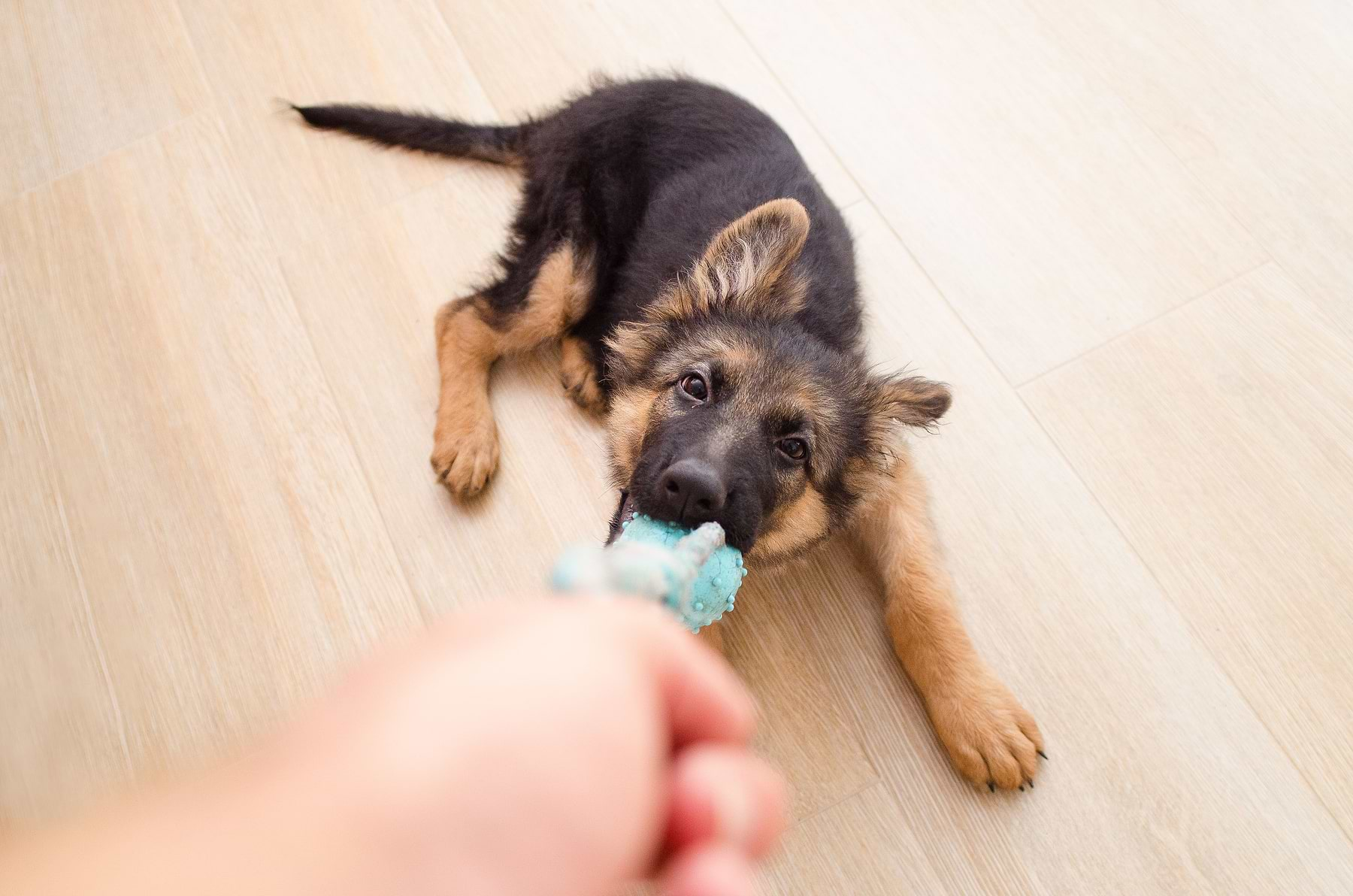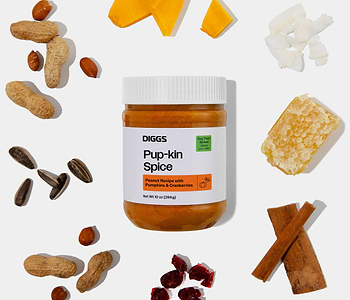Envision yourself working an excruciatingly long day in your home office and your dog is jumping on you, the counter, your desk, chasing their tail, rummaging through the plants, barking, pulling, spinning circles around you, the kids, your partner, the house! It’s zoomies, hip checks, licks, barks, and bites.
Your dog is hyper. Too hyper. Ever wonder how you can calm your incredibly energetic dog? We have, and we’ve got some hefty tips and tricks for you to try. Read onwards to understand not only how you can calm your hyper dog, but why your dog is hyper to begin with.
Many times, dogs are conditioned by their owners to be hyperactive. While it might be unintentional, it’s true. Hyperactivity usually gets your dog's attention (bad or good, it doesn’t really matter—attention is attention). And dogs sure do love attention! They are taught that being excitable is a good thing.
In addition to that, certain breeds are genetically predisposed to be more energetic than others. For instance, working dogs are active dogs and can have bundles of energy. Non-working dogs and other types of breeds are lower maintenance, senior-compatible, or lap dogs. Your dog’s DNA could be the reason why they are either constantly on the move, or constantly on your lap.
Lastly, hyperactivity could occasionally be a sign of an underlying medical issue. It’s always a good idea to check in with your vet in case your pup needs a prescribed medication to calm them down.
We don’t want to completely classify hyperactivity as a negative thing. Many times, the term "hyper" is stigmatized or associated with bad behavior, but hyper dogs are not necessarily more trouble than calmer dogs. Hyper dogs tend to be more inquisitive and curious, which isn’t really a bad thing.
So cut your pup some slack. Dogs are wonderfully fun and darling creatures by nature, so don’t prohibit them too much. If their hyperactivity isn’t cutting into your day, let their personalities flourish.
1. Daily Physical Exercise
Giving your dog daily exercise is guaranteed to calm them down. Have them run circles through the park or take them to a dog-friendly beach so they can splash through the waves. Caution though, as bringing your dog to a sandy environment will definitely lead to bathtime...or a wet, crunchy floor when you get home. Setting aside at least one hour a day to get your pup going is not only good for their heart health but a great way to tucker them out.
Some suggestions for outdoor physical play are:
- An unleashed dog park
- A dog-friendly beach
- A walk through your neighborhood
- A game of fetch in your backyard
- Puppy play class
2. Give Them a Hobby
The bottom line is that dogs need both mental and physical stimulation in order to thrive. There are tons of safe and interactive toys out there that will keep your pet busy. The great thing about interactive toys is that they require your pet’s full participation and engagement. Here are some examples of interactive toys that will keep your pet busy, which will inevitably tire them out.
Kibble-Dispensing Toys
It’s all about incentive! Give your dog a reason to not only engage but to stick with it. Kibble-dispensing toys usually require the push of a button, or some other tick of a box, for a little treat to be released. By design, they challenge your dog to use their natural animal instincts and a little creativity to dislodge the mini-prizes. These toys keep your pet fixated and ready for more. They’ll top off their session with a nice, long nap. You can also try an enrichment tool which prompts your pet to keep licking and has a calming effect.
Treat-Dispensing Puzzles
Puzzles are a great way to keep your pup busy as well. Consider this a level up from kibble-dispensing toys. Puzzles require your dog to solve a problem, which is a great challenge that encourages a ton of mental stimulation.
Mental stimulation is sure to calm your pet and lessen their hyperactivity. Remember to buy the level of difficulty that makes the most sense for your companion in regards to their age and their breed. A puzzle that is too challenging will leave your pet frustrated and more inclined to give up.
The Diggs Groov and Treat Spread are another option to keep your pup engaged and simulating without causing frustration.
Hide and Seek Toys
Hide and seek toys are a great way to calm your canine companion and keep them busy. These toys usually come with detachable pieces that you’re required to hide within the home base of the object. They are good for heavier dogs that don’t necessarily need those caloric treats, as these toys don’t use food as an incentive.
3. Calming Treats
There are treats that you can give your dog to take the edge off and calm them down. Feeding your canine companion calming dental sticks or chews is a good way to soothe them.
These treats are usually made with calming properties and typically contain Valerian root, hemp, and chamomile. Read through every ingredient on the packaging and consult your vet before giving your pet something new. Every dog is different!
The calming ingredients typically take a moment to kick in, so give your pup the time they deserve. It’s best to have them finish the chew or treat before you leave the house, as it is always safer for them to consume if they are supervised.
4. Crate Train
Crate training is a good way to keep your dog’s energy levels to a minimum. The first step is to invest in a durable, high-quality crate for your pet, like one that collapses and is easy to set up and transport.
Supply the crate with a blanket or an orthopedic pet pad, making the space nice and snug. Lastly, incorporate a crate training aid that will teach your pet to love their home within a home. A crate training tool that encourages licking has been proven to have a calming effect on dogs.
Start slow and allow this to be a gradual process. You can put your dog in their crates several times throughout the day, even when you are home. In fact, if you only put your pup in a crate when you leave the house, they will start to think that the crate is a punishment. Small increments of time throughout the day is the best way to go about it. Crate training is known to give your dog peace of mind, ease their anxieties and calm them down.
5. Routine and Flow
Supplying your canine companion with a smooth-flowing daily routine is a great way to lessen their hyperactivity. Remember that consistency is key. Many times, hyperactivity stems from unpredictability and your dog having free reign over their day. Solidify a schedule that works for both of you.
Keep on top of this. Dogs typically have a positive reaction to structure. A sample daily routine for your pet could be the following:
- Wake up and bathroom break
- Feed breakfast to kickstart their day and fuel them up
- Relax or play for decompression
- Midday bathroom break or long walk outside
- Afternoon play session at a local park or in the backyard
- Nighttime walk
- Relax or play for decompression
- Final bathroom break
- Bedtime
Teaching your dog when it’s time for play and time for rest is an effective way to calm them down.
6. Basic Commands
Teaching your dog how to execute basic commands is a great way to calm their hyperactivity. Basic commands will teach them general etiquette, manners and will also keep them out of trouble.
To put it simply, obedience training is the key to managing your canine companion. This requires work from the pet parent as well. Remember that training your dog takes time, so patience is an important part of the process.
Basic commands include sit, stay, come, and down. Your dog having a grasp on these commands equates to more control over your pup. Your dog greeting someone politely at the door, coming when they are called, or walking safely and controllably on a leash are basic desirable behaviors that will help you manage your pet. A hyper dog that’s able to come when called and sit when asked makes the pet parent’s life a lot easier.
7. A Healthy Diet
It’s understandable to want to save costs wherever possible, but it’s good to invest in healthy foods for your pet when possible. What your dog eats has a direct impact on how they behave and how they feel on the inside. It’s typical to see fillers, byproducts, coloring, and sugar in cheaper food brands.
Studies have drawn loose correlations between hyperactivity and certain dog food ingredients, so it makes sense to feed your dog a high-quality food. As a reminder, consult your vet before making any shifts in your dog’s food.
8. Your Energy
Let’s take a moment to remember that your dog is most likely very in tune with your energy and the way you behave. If your house is chaotic, filled with screaming children, blasting music, so on and so forth, your pup is likely going to take that in and match the energy in the room. Look inward and be aware of your energy.
In nature, when one dog in a pack becomes excited or on high alert, the rest will follow. If one dog in a household begins to bark, the other dog will likely start barking as well. Consider that for a moment. When the leader of the pack amps up, the rest of the pack will follow. When the leader of the pack is cool, calm, and collected, the rest of the pack will follow.
9. Consult Your Vet
There are some medical explanations for hyperactivity in dogs. It’s always healthy to check in with your vet if you have an extremely hyper animal in your home. Sometimes, metabolic diseases can manifest themselves as hyperactivity, meaning your dog does not have control over their energetic state. Talk to your pet’s doctor and see if there are any underlying causes that require medication or testing.
Summary
In conclusion, there are a number of things you can do to try and calm down your hyper dog. The first step is to try and understand why your pup is so hyper to begin with. Is it the energy of the room? The energy of the pet parents? Or is it neither, and simply has to do with the breed’s genetic predisposition? It’s good to get to the bottom of this.
Daily exercise, interactive toys, and calming treats are sure to help. Same with crate training, a proper routine that flows smoothly throughout the day, and your furry friend learning basic commands. Again, these things take time and patience is a must.
Lastly, supplying your dog with a healthy diet and being in tune with their energy is an effective way to calm your pup. It’s never a bad idea to chat with your vet and see if there are underlying causes to the madness! And remember, hyperactivity is not always a bad thing. Dogs just want to have fun.
Sources:
The 25 Best Interactive Dog Toys | Pawp
Dog Too Hyper: How to Calm an Energetic Dog or Hyperactive Puppy | American Kennel Club
Crate Training | Almost Home Humane

The Diggs Team
We believe our dogs deserve safer, better designed pet products.
You might also like
Crate training tips, stories and inspiration
View all blogsIn Your Diggs
Share your photos with #DiggsPet and tag us @DiggsPet on IG and TikTok.






